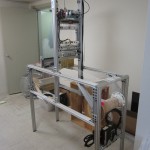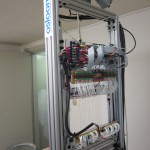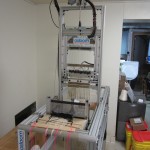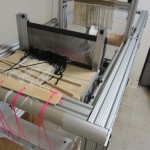Osloom: Unterschied zwischen den Versionen
(Die Seite wurde neu angelegt: „{{Projekt |projectname=osloom |subcat=Computer, Elektronik |Images={{ProjektImages |projectimage=144.1.jpg }}{{ProjektImages |projectimage=144.2.jpg }}{{Projek…“) |
|||
| (3 dazwischenliegende Versionen von einem anderen Benutzer werden nicht angezeigt) | |||
| Zeile 1: | Zeile 1: | ||
{{Projekt | {{Projekt | ||
|projectname=osloom | |projectname=osloom | ||
| − | |subcat= | + | |kewords_de=3D-Drucker |
| + | |kewords_en=3D printer | ||
| + | |kewords_es=Impresora 3D | ||
| + | |subcat=Looms | ||
|Images={{ProjektImages | |Images={{ProjektImages | ||
|projectimage=144.1.jpg | |projectimage=144.1.jpg | ||
| Zeile 14: | Zeile 17: | ||
}} | }} | ||
|firstin=http://www.osloom.org/ | |firstin=http://www.osloom.org/ | ||
| − | | | + | |typeproject=TUBerlin |
|lang=English | |lang=English | ||
| − | |||
|project_status=Inactive | |project_status=Inactive | ||
|maturity=prototype | |maturity=prototype | ||
| + | |cad_files_editable=No | ||
| + | |assembly_instructions_editable=No | ||
| + | |bill_materials_editable=No | ||
| + | |free_redist_allowed_licence=Yes | ||
|open_o_meter=1 | |open_o_meter=1 | ||
|product_category=Arts & Entertainment | |product_category=Arts & Entertainment | ||
| Zeile 24: | Zeile 30: | ||
|original_elect_h=No | |original_elect_h=No | ||
|original_soft=No | |original_soft=No | ||
| − | | | + | |desc=OSLOOM (short for OPEN SOURCE LOOM) is a project aimed at creating an open source electromechanical thread-controlled floor loom that will be computer controlled. A [http://en.wikipedia.org/wiki/Loom loom] is a device used to weave fabric. The loom itself will be a Jacquard style loom. Jacquard looms allow for the individual control of each thread which in turn allows for photographic imagery to be woven. Jacquard looms like this exist commercially but they are very expensive (upwards of $30,000) which puts them out of reach for individuals and small educational facilities.The OSLOOM could be produced way more economically than that and truly revolutionize what the studio weaver could accomplish. The idea of a DIY open source loom is one that not only artists could benefit from but many individuals and learning centers could gain a resource by building one of these looms as well.OSLOOM would have an impact on (but not limited to) the following communities/sectors: |
| − | + | ||
| − | + | artists, DIY/makers, studio weaves, educational, institutions (large and small), textile designers, developing countries | |
| − | + | ||
| + | I believe that in order for a loom such as OSLOOM to have the greatest amount of impact it would need to operate on an open source platform. Therefore the software to operate the loom will be [http://www.tapr.org/ohl.html GPL] (General Public Licensed) and the hardware will be [http://www.tapr.org/ohl.html OHL] (Open Hardware Licensed). This would allow other individuals or groups to create this loom or to further develop this loom in the form of a derivative loom. | ||
| + | |||
| + | This project is inspired by [http://fab.cba.mit.edu/ MIT’s FabLab] concept and other open source hardware projects such as the [http://reprap.org/bin/view/Main/WebHome RepRap] and [http://fabathome.org/wiki/index.php?title=Main_Page Fab@Home] 3D rapid prototypers and the many DIY CNC projects available already. | ||
}} | }} | ||
{{ProjektLink | {{ProjektLink | ||
Aktuelle Version vom 12. März 2019, 13:23 Uhr
|
|
osloom Basic Data Category: Looms URL (first publication): http://www.osloom.org/
Project status:
Technical documentation Maturity of the project:
no no
Other
Assembly instructions are editable: Bill of materials is editable: Design files are in original format: No Free redistribution is allowed licence: No
Project management
Open-o-meter: 0 Product category: Arts & Entertainment Contains original non-electronic hardware: Contains original electronic hardware: Contains original software: |
Description
OSLOOM (short for OPEN SOURCE LOOM) is a project aimed at creating an open source electromechanical thread-controlled floor loom that will be computer controlled. A loom is a device used to weave fabric. The loom itself will be a Jacquard style loom. Jacquard looms allow for the individual control of each thread which in turn allows for photographic imagery to be woven. Jacquard looms like this exist commercially but they are very expensive (upwards of $30,000) which puts them out of reach for individuals and small educational facilities.The OSLOOM could be produced way more economically than that and truly revolutionize what the studio weaver could accomplish. The idea of a DIY open source loom is one that not only artists could benefit from but many individuals and learning centers could gain a resource by building one of these looms as well.OSLOOM would have an impact on (but not limited to) the following communities/sectors:
artists, DIY/makers, studio weaves, educational, institutions (large and small), textile designers, developing countries
I believe that in order for a loom such as OSLOOM to have the greatest amount of impact it would need to operate on an open source platform. Therefore the software to operate the loom will be GPL (General Public Licensed) and the hardware will be OHL (Open Hardware Licensed). This would allow other individuals or groups to create this loom or to further develop this loom in the form of a derivative loom.
This project is inspired by MIT’s FabLab concept and other open source hardware projects such as the RepRap and Fab@Home 3D rapid prototypers and the many DIY CNC projects available already.





